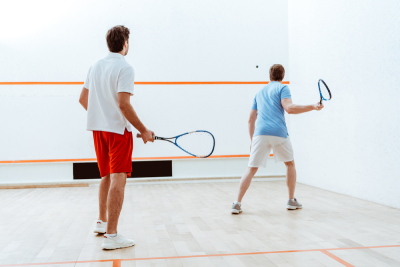
A squash court is a specialized indoor or outdoor area designed for one of the fastest-paced racquet sports in the world. Whether you’re a beginner or a professional, understanding the layout, dimensions, and features of a squash court is essential. In this guide, we’ll explore everything you need to know about squash courts, from standard specifications and rules to squash court construction and the possibility of building an outdoor squash court.

Content
Overview of a Squash Court
A Court zone is a four-walled enclosed space with specific measurements and markings. The game is played with two players (singles) or four players (doubles), and the ball must hit the walls and floor within defined limits.
Each court is composed of a front wall, back wall, two side walls, and a floor with distinct service and play markings. Courts may be constructed indoors or outdoors, depending on their purpose and local climate.
Squash Court Specifications
A standard Court zone follows the dimensions approved by the World Squash Federation. There are two main types:
Singles Court Dimensions
- Length: 9.75 meters (32 feet)
- Width: 6.4 meters (21 feet)
- Height to Front Wall Line: 4.57 meters (15 feet)
- Height to Back Wall Line: 2.13 meters (7 feet)
- Service Line Height (Front Wall): 1.78 meters (5.8 feet)
- Tin Height: 0.48 meters (19 inches)
- Distance Between Short Line and Back Wall: 4.26 meters (14 feet)
Doubles Court Dimensions
- Length: 9.75 meters
- Width: 7.62 meters (25 feet)
The increased width in doubles courts allows for the additional players, creating a slightly different play dynamic. These squash game court size rules must be adhered to for official gameplay.
Wall and Floor Components
Each wall in a Court zone serves a specific function:
- Front Wall: Must have high durability to absorb constant impacts. It’s where most shots are aimed.
- Back Wall: Typically made of glass in professional courts to allow for spectator viewing.
- Side Walls: Ensure the ball stays in play; surfaces must be smooth and uniformly painted.
- Floor: Often constructed from hardwood and must provide slip resistance and ball bounce. Includes service boxes and the short line.
Court Markings
- Short Line: Divides the front and back halves of the court.
- Service Boxes: Marked on both sides, where players stand to serve.
- Half Court Line: Runs perpendicular to the short line.
- Out Lines: Border the playable area on the front, back, and side walls.
These lines are crucial for ensuring fair gameplay and enforcing squash court rules.
Squash Court Rules Overview
Understanding court space rules is essential before stepping onto the court:
- Serving: Players must serve with at least one foot inside the service box. The ball must hit the front wall above the service line and land in the opposite back quarter.
- Rally: The ball can only hit the floor once before being returned. It must strike the front wall on every shot.
- Scoring: Matches are usually best-of-five games, with each game played to 11 points. Points can be won on every rally (rally scoring).
- Let and Stroke: Players can request a let (replay) if they feel obstructed. A stroke is awarded if one player prevents the other from hitting a valid return.
Rules must be followed strictly, particularly in competitive matches, to ensure safety and fair play.
Squash Court Construction Guidelines

Creating a durable and regulation-compliant court involves several considerations:
Site Selection
Choose a level, dry location, ideally indoors to reduce maintenance. If planning an outdoor court space, weatherproof materials are crucial.
Materials
- Walls: Reinforced concrete or prefabricated wall panels.
- Flooring: Maple or beech hardwood is ideal. Synthetic surfaces can be used in multi-purpose facilities.
- Glass Walls: For back walls, especially in commercial and tournament courts.
Dimensions & Layout
Follow the standard squash game court size and layout as described earlier. Accurate installation of markings and proper lighting placement is essential.
Ventilation and Lighting
Good ventilation prevents moisture buildup, and overhead lighting should be evenly distributed and glare-free.
Proper court zone construction enhances player experience and court longevity.
Building an Outdoor Squash Court
Although squash is traditionally played indoors, outdoor courts are gaining popularity for recreational play.
Key Considerations:
- Weatherproof Materials: Use UV- and water-resistant surfaces.
- Drainage: Ensure proper court drainage to prevent water pooling.
- Fencing: Outdoor courts may use fencing or transparent walls to maintain visibility while containing the ball.
Outdoor versions are ideal for parks, schools, and community centers looking to expand fitness infrastructure.
Maintenance Best Practices
Regular upkeep ensures performance and safety:
- Sweep and clean the floor weekly.
- Repaint court lines annually.
- Inspect walls and replace damaged panels.
- Ensure adequate lighting and ventilation.
Conclusion
A court space is more than just a play area—it’s a precision-designed space tailored for high-speed action. Whether you’re constructing one from scratch or updating an existing facility, knowing the correct court space specifications, understanding squash court rules, and considering the possibilities of an outdoor court space will ensure you’re creating a venue that supports both casual and competitive play. A well-built court based on regulation squash game court size will enhance gameplay and player satisfaction.
FAQs About Squash Court
Q1: Can a squash court be built outdoors?
Yes, an outdoor squash court can be constructed using weather-resistant materials, appropriate drainage systems, and fencing or walls to contain play.
Q2: What is the standard size of a squash court?
A singles squash game court size is 9.75m long and 6.4m wide, while a doubles court is wider at 7.62m. Height and markings must also comply with official standards.

Eldon Barrett’s knowledge of sports is boundless. His in-depth analysis and captivating storytelling will make you see the games you love in a whole new light.
